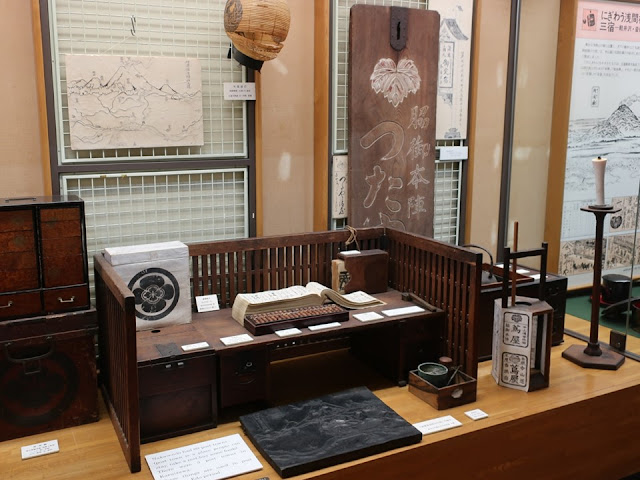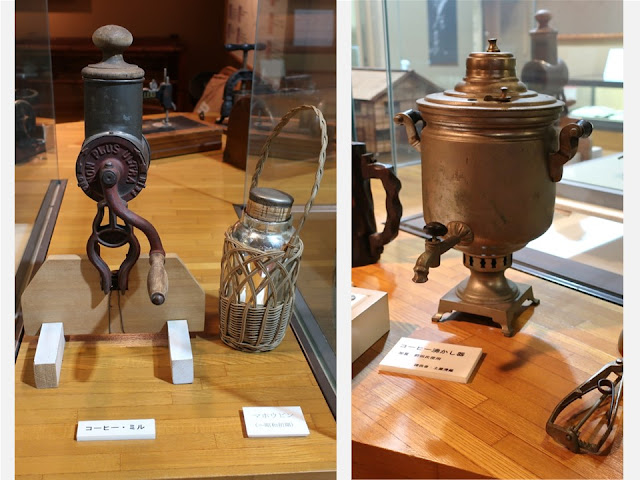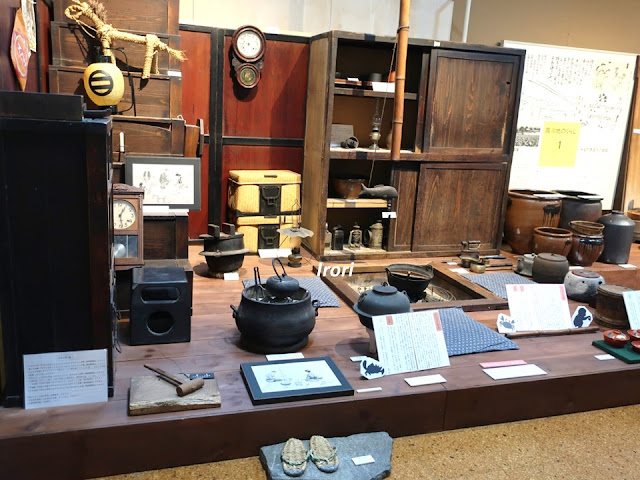Karuizawa, which is one of the most popular summer resorts, was a post town of an old
highway called Nakasendou. The museum is near the road and shows us the history. I found rare exhibits such as bells attached to a horse. Photos were taken and uploaded under the permission of the
museum office.
日本を代表する避暑地・別荘地の軽井沢は、中山道の宿場町でした。資料館は街道のほど近くにあり、宿場だった時代、別荘地になった時代などを分かりやすく紹介しています。馬に付ける鈴など、珍しい品が展示されていました。資料館の許可を得て撮影及び掲載しました。
The classy museum in the forest is looks like a villa.
資料館は、旧中山道から少し上がった森の中にあり、別荘風の上品な建物です。
There is a large panel inside the entrance of the exhibition area. Karuizawa is in a highland (the elevation is around 1000m); it’s not a good place to grow rice because of the cool weather. Moreover, Mt. Asama is an active volcano, that has occasional eruptions. It wasn’t easy to live there.
In the Edo period (1603~1868), the highway which links Tokyo and Kyoto (Nakasendou) was developed, and Karuizawa became an authorized post town. It’s before the difficult place (Usui Pass), so many travelers stayed at Karuizawa. It was a busy post town. Let’s tour the room.
展示室に入ると、ドーンとパネルがあります。軽井沢は標高が約1000m、そして浅間山の噴火に大変な苦労をしてきた地域です。お金になる米を作るには適した土地ではありませんでした。
でも、江戸時代に中山道が整備され、難所・碓氷峠を越える手前の宿場として繁盛しました。では、館内を見ていきましょう。
Ancient period section comes at first. There was already an official road from Kyoto (old capital) to eastern and northern Japan.
原始時代・古代の展示から始まります。京から東国への道が整備されていました。
I proceeded to the section of Karuizawa in the Edo period. It was a peaceful era.
Nakasendou highway was popular because of its view in a mountainous region, plus travelers were not blocked by a swollen river (it often happened in Toukaidou which also linked Tokyo and Kyoto). When people in eastern Japan traveled to west, they went on Tokaidou and returned on Nakasendou (The history of travel of Japanese ordinary people (published in 1971) 2/2). I agree to select the other route during a round trip; they walked.
The earnings at the post town were valuable for Karuizawa people who lived in unsuitable land for farming, I think.
平和だった、江戸時代・軽井沢宿の展示のコーナーへ進みます。
中山道は景観が優れ、川止めの心配も少なかったということです。確かに、関東からは、東海道で伊勢、奈良、大阪、京都を回り、中山道で善光寺にお参りにして帰るルートが人気だったようです(庶民と旅の歴史 PartⅡ)。同じルートを、歩いて往復、はないですね。
高地で土が痩せていた軽井沢にとって、中山道の宿場町として稼ぎは貴重だったと思います。
Workers and horses were prepared at a post town to carry luggage or travelers to the next one. When the traffic volume increased, farmers were summoned in order to help it.
However, there were not villages near Karuizawa. Helpers came from a village even 40-50 km away. It’s too far! They spent two days to go to Karuizawa. The procession of a local lord (daimyo) went through during a farming season: the procession had three thousand people maximum. It’s a terrible burden for called farmers, I’m sure.
宿場では、旅人や荷物を隣の宿場に運ぶための人馬を用意していました。しかし、通行量が増えたときには近村から人馬を招集しました。助郷です。
近くに村がない軽井沢宿には40~50km離れた村からも人足が来ました。これは遠い! 軽井沢宿に行くだけで2日はかかってしまいます。外様大名の参勤交代は春、農繁期に入った頃に行われ、3000人規模の加賀藩も通行しました。農民には大きな負担になったと思います。
The exhibits above are furniture and utensils which were used inns for lords. Those were well made.
本陣・脇本陣で使われた什器です。弁当箱セットを含め良い品です。
A reception counter where an owner or a head clerk worked.
帳場の道具も一式展示されています。
There were three post towns in Karuizawa Town (Karuizawa, Kutsukake and Oiwake). All of them prospered. The tray (lower left) was used at a kou party; the kou member gathered and waited for the moon on the twnty-third night (in a lunar month, waning moon). It was an traditional event across Japan. They enjoyed eating dinner and chatting while waiting in a latenight probably.
軽井沢町にある三宿(軽井沢、沓掛、追分)は碓氷峠をひかえ、繁盛しました。左下は、二十三夜の月(下弦の月)を待つ集まり(講)で使われたお膳です。一汁三菜?、おしゃべりを楽しみながら深夜の月の出を待ったのでしょうね。
The travel diary was written by a famous scholar (Kaibara Ekiken). The illustrations shows Mt. Asama (active volcano, upper left) and the moutain road near Karuizawa. Traveling was not easy.
「養生訓」で有名な貝原益軒の旅日記が展示されています。挿絵には、噴煙を上げる浅間山(左)、軽井沢宿から沓掛宿への山道を馬で行く人々(右)が描かれています。大変な旅です。
Those bells were attached to a packhorse. The sound informed people of the horse walking, or it drove away wild animals, I'm not certain. Anyway, I have the image that a horse in an old time came with the bell sound.
荷馬に付けられた馬鈴。山道で「馬がいるよ~」と人に知らせるのか、獣を除けるためか、知らないのですが、馬は「シャンシャン」と鈴を鳴らしながら歩いているイメージがあります。では、馬の模型を見ましょう。
The man led three horses; Japanese horse wore straw shoes.
This was a side job of a farmer. They didn’t use horses in winter for farming, so they transported salt, ceramics and so on. It was a direct service (it didn’t need to trans-ship luggage at each post town), therefore it’s a fast service. Moreover, there were less chances to break goods by trans-shipping. Farmers worked not only for helping traffic of Nakasendou highway, but also did their own business.
馬子さんが三頭の馬を連れています。日本の馬は草鞋を履きました。
これは中馬と呼ばれた農民のアルバイトで、馬を使わない農閑期に塩や陶器などを運びました。宿場毎に荷物を載せ替える継ぎ立てと違って直行便なので、速くて荷の破損も少なかったそうです。農民たちは、助郷で使われるだけじゃなくて、街道を利用して、しっかりと稼いでいました。
Very severe notification is written the bulletin board in 1968; it's just after the shogunate was abolished. The former shogun (Tokugawa Yoshinobu) was censured and it was prohibited to support him.
生々しい内容の高札が展示されていました。読み下し文から(句点は私が記載)。
「徳川慶喜、天下の形勢やむを得ざると察し、大政返上、・・・。慶喜返上明白、始終朝廷を欺き奉り候段、大逆無遣、その罪遁るべからず、・・・。・・・賊徒と謀を通じ或は潜居致させ候者は朝敵同様、厳罰に処せらるべく候間、心得違いこれなき様致すべき事。参与。・・・尾州御取締 御影陣屋」
After the Edo period, the railway started its service in 1893. Karuizawa ended its role as a post town.
江戸時代が終わり、鉄道が開通し(1893年)、宿場町の役割は終わりました。
In the following Meiji period (1868-1912), many western people start living in Japan because of abolishing the national isolation policy. Karuizawa has flourished as a summer resort since then.
明治に入ると、西洋人が多数来日し、軽井沢は避暑地・別荘地として今日の繁栄を迎えます。別荘地としての軽井沢が紹介されています。富裕な人々の楽しみですね。
The coffee mill and boiler would suit to a lounge room of a western cottage.
コーヒーミル(左)とコーヒー沸かし器。暖炉がある家に似合いそうですね。
The owner of the cottage above was a former prime minister Fumimaro Konoe (1891-1945). We can see the elegant Japansese style rooms and the western style ones. It’s in the same site as the museum (five minute walk).
敷地内を5分ほど歩くと旧近衛文麿別荘(昭和初期の総理)があります。上質な和室と洋室を備えた内部が公開されています。
Folklore exhibition room、民俗資料展示室
There is an irori fireplace on a wooden floor room. Many old utensils and tools are exhibited.
部屋に入ると囲炉裏の間があり、民具がたくさん置かれています。
Skis, skates, farming equipment, sericulture tools and so on are displayed.
スケート下駄、スキー板、農機具、養蚕用具なども展示されています。
The manual fan was used while threshing.
右下の手回し扇風機は、脱穀の時に風を起こすとのこと。脱穀の時も風力選別も行ったのですね。
It is interesting that a picture near an exhibit shows us how to use it. It’s effective.
展示品の近くに使っている様子の絵が置かれています。とても分かりやすいと思います。
In a harvest festival (Toukan-ya, or literary tenth day night), children hit a ground by the straw rope. It was derived from getting rid of moles under a rice field. It was a fun event for children.
十日夜(とおかんや)の藁鉄砲。これで地面を叩きます。田のモグラ退治に由来すると書かれていました。収穫後のお祭りで、子どもたちにとっては楽しい行事だと思います。
The Karuizawa Ginza street, which is a popular tourist spot, was a center of the post town. There was an inn for lords and so on.
人気観光地の旧軽井沢銀座通りは、本陣などがあり軽井沢宿の中心部でした。
Tsuruya inn above was the east end of the post town. There was a defense facility (Masu-gata) in front. Tsuruya was an inn and a teahouse in the Edo period. Travelers took a rest before climbing Usui Pass. It remains a good atmosphere.
碓氷峠への上り坂に近い「つるや旅館」さんは、「休泊茶屋」だったそうです。茶屋の前に枡形(敵の侵入を妨げる施設)がありました。宿の前に「中山道軽井沢宿」の石柱が立っています。なんか雰囲気がありますね。
So, I head to Oiwake post town while enjoying the sight of Mt. Asama.
では、浅間山を見ながら、沓掛宿を経て追分宿に向かいます。
Visited in October, 2022
Official
website (in Japanese):
The
Karuizawa Museum of History and Culture、軽井沢町歴史民俗資料館 https://www.town.karuizawa.lg.jp/www/genre/1000100000047/index.html
Former
Konoe Fumimaro’s cottage、旧近衛文麿別荘 https://www.town.karuizawa.lg.jp/www/sp/genre/1487741876704/index.html, accessed in December, 2022
Special notice: Both facilities are
closed during winter. Just check the opening days on the official website. (FYI,
those were/are closed from 16th of November in 2022 to 31st
of March in 2023. Those were opened every day from 15th of July to
31st of October in 2022. On the other period, those were closed on
Monday except for a national holiday.)
特記事項:両館は、冬の間、休館になります(2022年度は11月16日~翌年3月31日が休館。それ以外の時期は、祝日を除く月曜日が休館日。7月15日~10月31日は無休でした)。開館日は、上記のオフィシャルサイトでご確認ください。
Previous post (old house related to a hero (Sakamoto
Ryoma) in the end of the Edo period in Nagasaki of western Japan、龍馬が拠点にした長崎の家です): Kameyama Shachu memorial hall、亀山社中記念館
Next post (Museum in the same town): Karuizawa Oiwakejuku Museum of Local History、軽井沢町追分宿郷土館

























Comments
Post a Comment